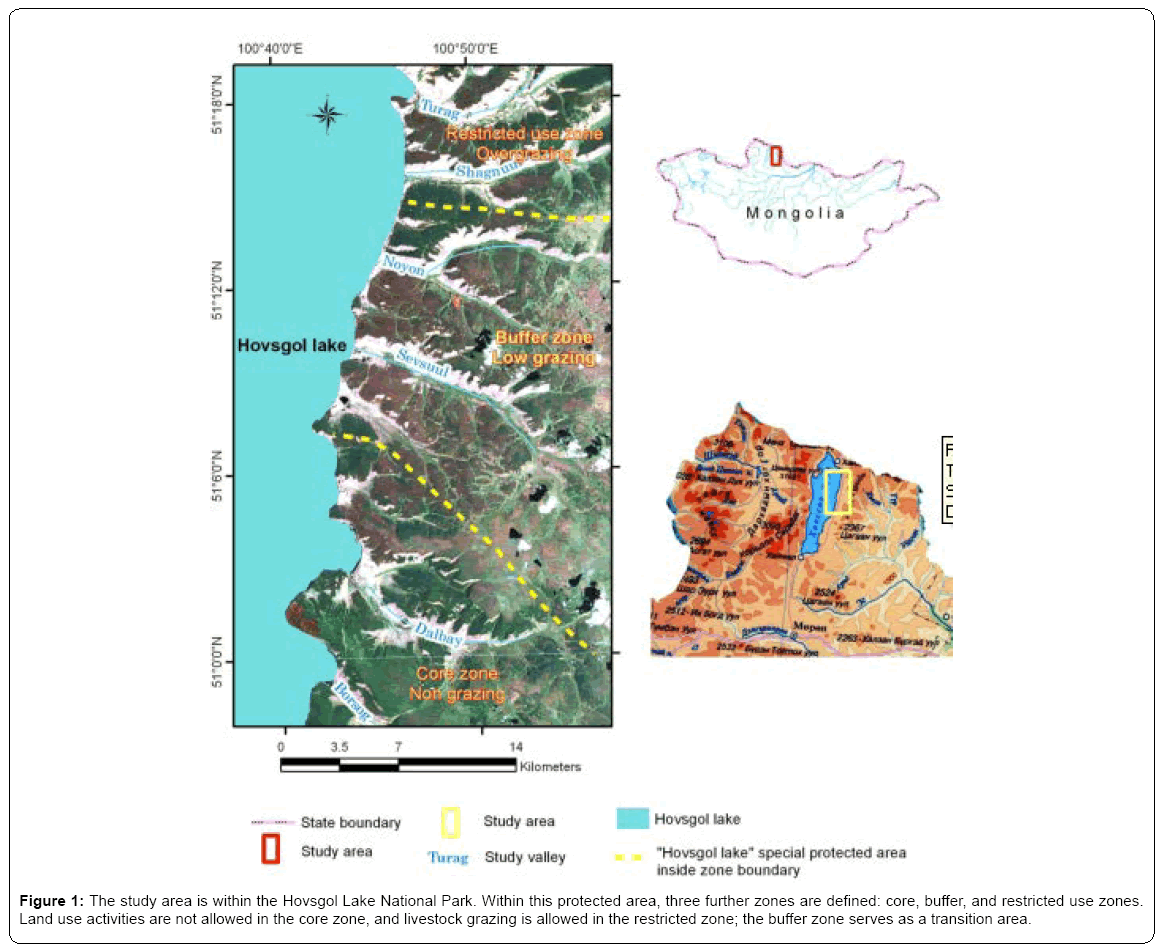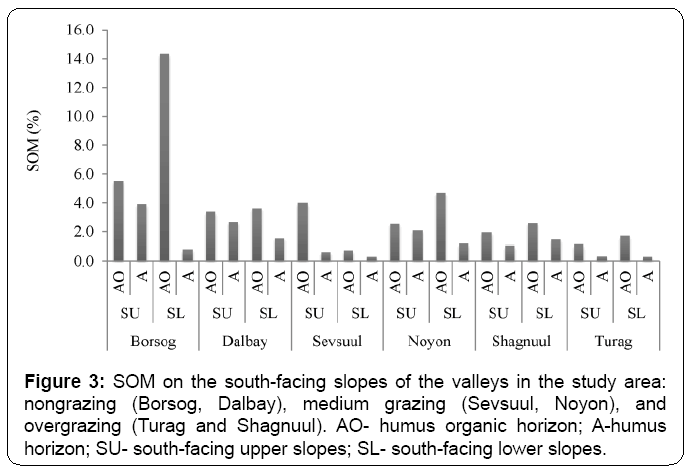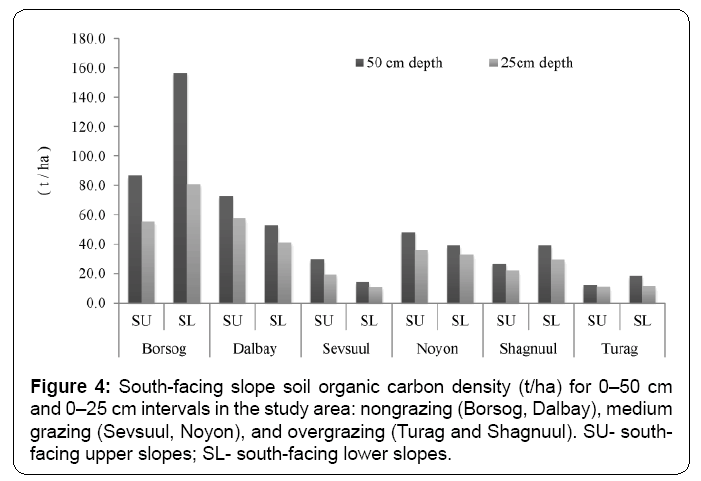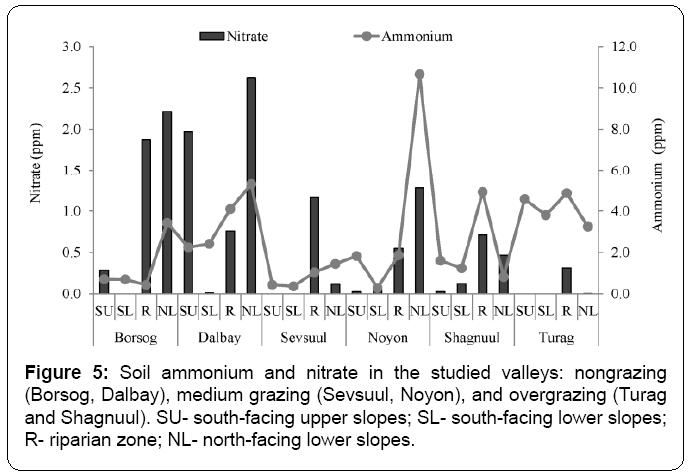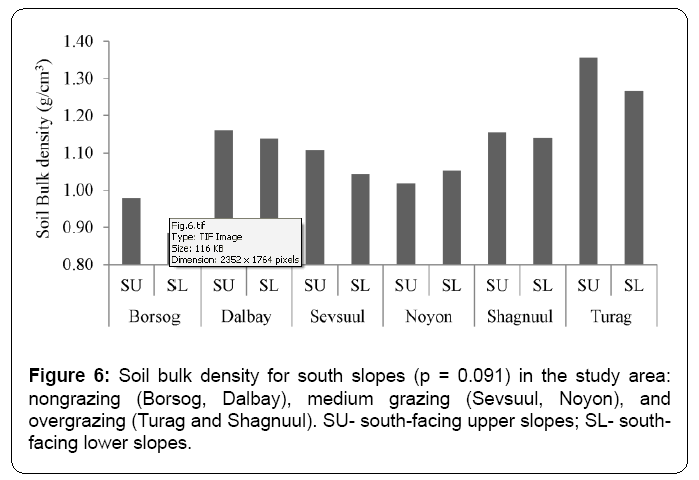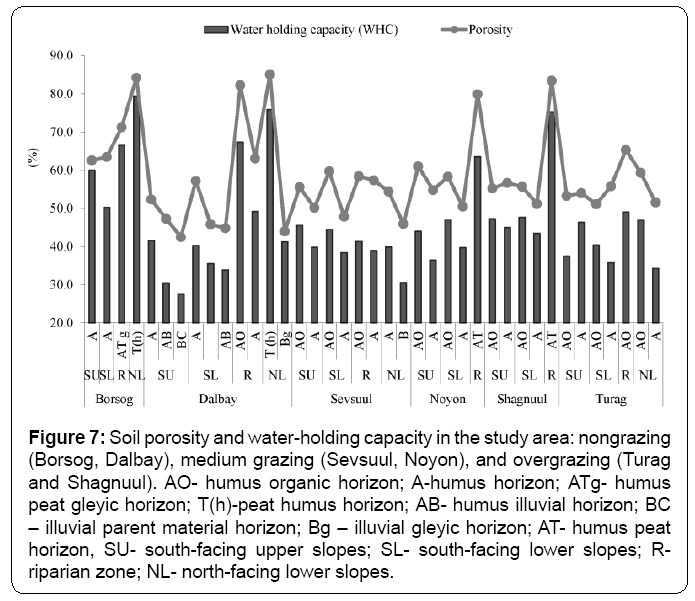Research Article Open Access
Impact of Overgrazing on Semiarid Ecosystem Soil Properties: A Case Study of the Eastern Hovsgol Lake Area, Mongolia
Qinxue Wang1* and Ochirbat Batkhishig21National Institute for Environmental Studies, 16-2 Onogawa, Tsukuba 305-8506, Japan
2Institute of Geography, Mongolian Academy of Sciences, SBD, 11-r horoolol, Ulaanbaatar 14192, Mongolia
- *Corresponding Author:
- Qinxue Wang
National Institute for Environmental Studies
16-2 Onogawa, Tsukuba 305-8506, Japan
Tel: +81-29-850-2128
E mail: wangqx@nies.go.jp
Received date: November 04 , 2013; Accepted date: January 28, 2014; Published date: February 06, 2014
Citation: Wang Q, Batkhishig O (2014) Impact of Overgrazing on Semiarid Ecosystem Soil Properties: A Case Study of the Eastern Hovsgol Lake Area, Mongolia. J Ecosys Ecograph 4:140. doi:10.4172/2157-7625.1000140
Copyright: © 2014 Wang Q, et al. This is an open-access article distributed under the terms of the Creative Commons Attribution License, which permits unrestricted use, distribution, and reproduction in any medium, provided the original author and source are credited.
Visit for more related articles at Journal of Ecosystem & Ecography
Abstract
The present study investigates the impacts of overgrazing on soil properties in eastern Hovsgol, Mongolia. The results have shown that soil fertility decreases and soil chemical properties change as a result of overgrazing and pasture degradation. In overgrazed areas, SOM content was 30-50% lower (p=0.012), and exchangeable calcium 40-60% lower when compared to non-grazing areas. Nitrate nitrogen content was also lower in overgrazed valleys. Overgrazing was also found to affect physical soil water properties, increasing topsoil temperature and decreasing moisture content. Moreover, topsoil becomes denser and more compact as a result of animal pressure on the soil surface, increasing bulk and particle density. The results indicate that overgrazing can lead to significant decreases in soil organic content and fertility, highlighting the need to implement soil conservation and pasture management policies based on traditional nomadic husbandry.
Keywords
Overgrazing; Soil cover; Soil properties; Soil organic matter; Hovsgol lake; Mongolia
Introduction
The impact of overgrazing on pasture and soil cover is considering as a major environmental problem in Mongolia. In the 20th century, the number of livestock in Mongolia was ~20 million. However, following privatization during the 1990s, this number rose to 44.8 million by 2009. As a result, pasture pressure increased, leading to soil degradation. Overgrazing resulted in gradual changes in the vegetation species, with a consequent reduction in diversity and loss of some native species [1].
The transition to the market economy in 1990 moved the control of nomadic husbandry management from central government regulation systems to private non-regulated systems. This has had many negative consequences. These include increased livestock concentration near water sources, movement frequency, and distance reducing etc. Moreover, mismanagement of rangeland is also known to be a factor [2] in land degradation. After privatization, many wells and water supply points were destroyed and large areas of pasture went unused. As a result, excessive numbers of domestic animals gathered around the remaining water points, increasing pasture pressure in the surrounding areas.
Strong evidence of pasture overgrazing was observed during the winter and spring of 2000, when nearly 3 million domestic animals died owing to a lack of sufficient pasture. Previous research has mostly focused on land use and the social and economic aspects of grazing land [3-5] and the impact of grazing on vegetation [6]. Soil degradation resulting from overgrazing is still poorly understood and has been the subject of few studies [7-9]. Accordingly, techniques for examining pasture soil degradation require further study. In particular, reliable data is required to help determine the severity of the problem of soil degradation [10]. This study aims to investigate the changes in soil properties caused by overgrazing in the Hovsgol region of Mongolia. This work was conducted within the framework of the World Bankfunded Long-Term Ecological Research (LTER) project entitled “Dynamics of biodiversity loss and permafrost melt in Lake Hovsgol National Park, Mongolia.”
Study Area and Measurements
The study area is within a region of mountain forest steppe, with forested north-facing slopes and non-forested south-facing slopes. The study area lies within a protected area, the Hovsgol Lake National Park (Figure 1). Within the protected area, three further zones are defined: core, buffer, and restricted use zones. Land use activities are not allowed in the core zone, and livestock grazing is allowed in the restricted zone; the buffer zone serves as a transition area. Here we chose six valleys with different grazing intensities: non-grazing (Borsog, Dalbay), medium grazing (Sevsuul, Noyon), and overgrazing (Turag and Shagnuul). The natural geographical conditions of the valleys are relatively similar: all valleys are oriented in a similar latitudinal direction and have forested north-facing slopes and non-forested south-facing slopes. The Sevsuul and Turag valleys have a steppe vegetation cover on the northfacing slopes. The Borsog, Dalbay, and Noyon valleys have primarily cryomorphic boggy north-facing slopes and riparian zones (Figure 1).
Figure 1: The study area is within the Hovsgol Lake National Park. Within this protected area, three further zones are defined: core, buffer, and restricted use zones. Land use activities are not allowed in the core zone, and livestock grazing is allowed in the restricted zone; the buffer zone serves as a transition area.
The study area is within the Hovsgol Lake National Park. Within this protected area, three further zones are defined: core, buffer, and restricted use zones. Land use activities are not allowed in the core zone, and livestock grazing is allowed in the restricted zone; the buffer zone serves as a transition area.
The south-facing steppe slope is the main grazing land in the Hovsgol Lake area. More livestock graze in the northern Shagnuul and Turag valleys and fewer in the southern valleys (Figure 2); no livestock graze in the Borsog valley. A total of 2746 head of livestock were counted at the beginning of 2004. Of these, 39.5%, 25.6%, 24.1%, and 10.7% were goats, cattle, sheep, and horses, respectively. Livestock do not necessarily graze constantly in one valley and may migrate to other areas during dry years. Around 60–70% of all livestock moved to the Turag valley during the winter season (Figure 2).
Number of livestock in the nongrazing (Borsog, Dalbay), medium grazing (Sevsuul, Noyon), and overgrazing (Turag and Shagnuul) valleys in the study area.
In each valley, soil profiles were established in the upper and lower parts of the south-facing slopes. We described the soil profiles at various sites based on several parameters: location, overall surface characteristics, slope steepness, aspect, erosion, drainage, groundwater, plant associations, canopy cover, and rock outcrops. We also conducted morphological soil descriptions, including variables such as soil color (based on a Munsell chart) and texture, soil structure and consistency, and moisture, root material, carbonates, and coarse fragment concentrations.
In the eastern Hovsgol lake areas, steppe or basic pasture areas are concentrated on south facing slopes while north-facing slopes are covered by forest. Therefore, we conducted detailed analyses of the upper and lower parts of south-facing valley slopes. The southfacing slopes of all valleys were similar, with non-carbonated Dark Kastanozem soils with sandy loam textures.
The combination of the cold–humid climate conditions, the wide distribution of permafrost, the presence of taiga forest, and the specific characteristics of the parent materials has formed a unique soil cover in the Hovsgol area. Taiga forest soil, Kastanozem, and boggy cryomorphic soils are distributed throughout the eastern Hovsgol Lake area. Sandy soils (some fixed, some with mobile dunes) are distributed along the eastern shoreline (i.e., the Sevsuul, Dalbay, and Noyon valleys) of Hovsgol Lake, while noncarbonated Kastanozem soils and sandy sediments are distributed throughout the mountain steppe parts of the region [11]. The descriptions of soil profile in each valley are listed in (Table 1).
| Borsog valley | a. Profile BRG-05: N 50°58’23.8”, E 100°44’46.5”, Altitude = 1776 m a.s.l. |
| Soil horizons and depths: “AO”0–7 cm, “A”7–35 cm, BC 35–55 cm. Southwest-facing upper slope, inclination 40–45°; Abundant surface boulders, debris, basaltic rocks, stone coverage 30–40%, with a 1-cm thick silt layer accumulated between grass roots on top of the soil. Sedge–forb meadow: canopy cover 90%. | |
| b. Profile BRG-07: N 50°58’09.7”, E 100°44’24.2”, Altitude = 1678 m a.s.l. | |
| Soil horizons and depths: “A”0–10 cm, “BCg”10–30 cm, “Cg” 30–60 cm. South foot-slope, inclination 5–6°; Sedge–forb meadow: canopy cover 70–80%. | |
| Dalbay valley | a. Profile DLB-01: N 51°01’52”, E 100°45’27”, Altitude = 1724 m a.s.l. |
| Soil horizons and depths: “A”0–12 cm, “AB”12–24 cm, “BC” 24–35 cm, “C” 35–60 cm. South-facing slope, upper steppe; Kobresia–fescue–forb steppe: canopy cover 60–70% and dominated by Carex sp, Festuca lenensis, Potentilla sp, and Artemisia frigida. Granitic outcrops at the surface, sandy silty accumulations. | |
| b. Profile DLB-02: N 51°01’ 26.1”, E 100°45’49.3”, Altitude = 1686 m a.s.l. | |
| Soil horizons and depths: “A”0–22 cm, “AB”22–35 cm, “BC” 35–45 cm, “C” 45–80 cm. South-facing foot-slope, Inclination 10–12°; Fescue–forb meadow–steppe: canopy cover 70–80%. No outcrops on the surface. | |
| Sevsuul valley | a. Profile SVL-01: N 51°10’31”, E 100°45’02”, Altitude = 1795 m a.s.l. |
| Soil horizons and depths: “AO”0–5 cm, “A”5–30 cm, “B” 30–50 cm, “C” 50–70 cm. Lower slope, north of Sevsuul River, slope inclination 10°; Festuca–Cleistogenes forb steppe: canopy cover 50%, dominated by Thymus sp, Artemisia frigida, Potentilla sp, Cleisotogenes squarrosa, Carex duriuscula, Leymus chinensis, Pulsatilla. | |
| b. Profile SVL-02: N 51°10’00.1”, E 100°45’148”, Altitude = 1668 m a.s.l. | |
| Soil horizons and depths: “AO”0–6 cm, “A”6–25 cm, “B” 25–45 cm, “C” 45–80 cm. First terrace of Sevsuul River; Forb–grass steppe: canopy cover 50%, dominated by Artemisia, Potentilla, Carex, Cleistogenes sp. | |
| Noyon valley | a. Profile NYN-01: N 51°12’30”, E 100°48’38.1”, Altitude = 1757 m a.s.l. |
| Soil horizons and depths: “AO” 0–5 cm, “A”5–25 cm, “B” 25–35 cm, “BC” 35–50 cm, “C” 50–70 cm. South upper slope, inclination 25–30°, 100 m down from top of mountains; Sedge–grass–forb steppe: canopy cover 60%, dominated by Potentilla sp, Stipa sp, granitic sandy gravel on the surface. | |
| b. Profile NYN-02: N 51°12’26”, E 100°48’23”, Altitude = 1713 m a.s.l. | |
| Soil horizons and depths: “AO” 0–6 cm, “A”6–23 cm, “B” 23–48 cm, “C1” 48–70 cm, “C2” 70–160 cm. Foot slope, inclination 5–6°; 100 m east of nomads’ summer shelters, livestock manure covers 20–30%; Grass–sedge–forb meadow–steppe: canopy cover 70%, dominated by Potentilla acaulis, Veronica incana, Carex duriuscula, Cleistogenes squarrosa, Festuca rubra, Festuca ovina, Potentilla fragarioides, Artemisia mongolica, Koeleria sibirica. | |
| Shagnuul valley | a. Profile SGL-01: N 51°15’51”, E 100°50’36”, Altitude = 1783 m a.s.l. |
| Soil horizons and depths: “AO” 0–7 cm, “A”7–24 cm, “B” 24–45 cm, “C” 45–70 cm. Upper part of southeast-facing slope, inclination 15°. Fescue–forb steppe: canopy cover 60%, dominated by Festuca lenensis, Carex sp, Potentilla sp, Artemisia frigida, and lichen, among others; Some rocks on the surface. | |
| b. Profile SGL-02: N 51°15’42”, E 100°50’44”, Altitude = 1728 m a.s.l. | |
| Soil horizons and depths: “AO” 0–6 cm, “A”6–23 cm, “B” 23–45 cm, “BC” 45–70 cm. South-facing foot slope, inclination 6–8°; Granitic stones on the surface; Artemisia–Potentilla–sedge steppe: canopy cover 60%; None of soil profile effervesced by 10% HCl. | |
| Turag valley | a. Profile TRG-02: N 51°17’34.7”, E 100°49’18.7”, Altitude = 1719 m a.s.l. |
| Soil horizons and depths: “AO” 0–8 cm, “A”8–24 cm, “AB” 24–35 cm, “B” 35–60 cm, “C” 35–60 cm. River valley, middle part, south-facing upper slope, inclination 20°; 30–40% of surface covered by sands; Surface rocks fragments 5–10%; livestock manure covers about 20%. Vegetation coverage is 50–60%, dominated by Artemisia frigida, Cleistogenes squarrosa, Festuca lenensis, Poa attenuata, Potentilla sp. Some accumulation of calcium carbonate was from 50 cm depth. | |
| b. Profile TRG-03: N 51°17’30.5”, E 100°49’13.6”, Altitude = 1679 m a.s.l. | |
| Soil horizons and depths: “AO” 0–6 cm, “A”6–40 cm, “AB” 40–60 cm, “BC” 60–90 cm. South-facing lower slope, 50 meter higher above floodplain level; Vegetation coverage is 60%, dominated by Artemisia frigida, Potentilla acaulis, Stipa krylovii, Festuca lenensis. Slope inclination 10°, fine sandy gravels accumulated on the surface between roots. Livestock manure covers about 20%. |
Table 1: Soil profile information in each valley of the eastern Hovsgol lake areas.
Physical characteristics of soil water such as temperature, moisture, bulk density, and particle density were determined using various methods. For bulk density, three replicates for each horizon were sampled by cylinders, oven dried, and measured. Soil moisture was measured by a time-domain reflectometer (TDR; HydroSense, Campbell Scientific) at depths of 10, 20, 40, 60, and 80 cm. Soil temperature was also measured at these depths. pH was measured by a pH meter, conductivity by EC meter, soil organic matter (SOM) by titration, mobile phosphorus by spectrophotometer (1% ammonium carbonate), mobile potassium by flame spectrometer, nitrate by spectrophotometer (sodium acetate), ammonium by spectrophotometer (potassium chloride), and particle density by pycnometer. Field investigation was conducted in 2004. A total of 12 soil profiles were investigated, and 51 soil samples (taken from all soil horizons) were analyzed. Samples were analyzed in the soil laboratory of the Institute of Geography at the Mongolian Academy of Sciences. Soil samples were air dried and separated using a 2-mm sieve.
Results and Discussions
Kastanozem soil characteristics
Dark Kastanozem soil is distributed on south-facing slopes under forb–grass steppe vegetation. This area is the main grazing land in the eastern Hovsgol area. Dark Kastanozem soils horizons are not clearly differentiated, with very gradual transitions between horizons. Gravel content is low in these soil profiles. This soil type is characterized by humic horizons with thicknesses of 20–40 cm and humic concentrations of 1.11–1.71% in the topsoil. These concentrations decrease with depth. Soils are neutral or slightly alkaline, with pH of 6.8–7.7, and carbonates do not usually accumulate in these soils. However, in the Turag valley, small accumulations of calcium carbonate (0.09-0.16%) were found in soils at depths of 40-60 cm. In profile TRG-02, the exchangeable calcium content was found to increase with greater depth, which is indicative of the movement and accumulation of calcium carbonate. Available potassium (28.4-21.8 mg/100 g) concentration was higher than in the Dalbay valley soils, and phosphorus concentrations were between 2.0-3.1 mg/100 g. Texturally, these soils were classified as sandy loams dominated by the sand fraction.
Soil organic matter change
Soil organic matter (SOM) content is a basic indicator of soil fertility, and it significantly influences soil properties and plant growth [12]. SOM content was slightly higher in low-level grazing areas in the southern valleys (Borsog, Dalbay) than in overgrazed areas in the northern valleys (p = 0.2533). SOM was 30-50% lower in the overgrazed Turag valley than in the non-grazed Dalbay valley (Figure 3). This indicates that loss of soil fertility can occur as a result of overgrazing.
SOM on the south-facing slopes of the valleys in the study area: nongrazing (Borsog, Dalbay), medium grazing (Sevsuul, Noyon), and overgrazing (Turag and Shagnuul). AO-humus organic horizon; A-humus horizon; SU- south-facing upper slopes; SL- south-facing lower slopes.
Plant roots tend to be concentrated in the top humus (AO) horizon. The SOM content of this horizon is higher than that in the underlying A horizon. Changes in SOM content are very clear in the south-facing slopes. There is a marked decreasing linear trend in SOM in the overgrazed valleys. This decreasing trend was more significant (p = 0.012) in the south-facing slope soils than in data from four strata including valley bottom and forest. SOM content in the Noyon valley (4.69–2.55%) is nearly twice that in the northern overgrazed valleys (Shagnuul: 1.95–2.61%, Turag: 1.11–1.71%).
Soil organic carbon density
The main indicator of the nutrient fertility potential of soil is the soil organic carbon density (SOCD), which is the total mass of organic carbon of a certain thickness of soil in a specific location.
SOCD = SOC × BD × h (1)
Where SOCD: Soil Organic Carbon Density (Mg ha-1), SOC: soil organic carbon (%), BD: bulk soil density (g/cm3), h: thickness of soil (0–50 cm and 0–25 cm).
We calculated the SOCD for the 0-50 cm and 0-25 cm intervals over a 1-hectare area. Some of the cryomorphic peaty soil was frozen to depths of 20 or 30 cm; therefore, SOCD was not calculated for the 0–50 cm intervals in these locations. The highest SOCD was found in a cryomorphic boggy soil on the lower north-facing slopes of the Noyon valley, where SOCD was 335.51 Mg.ha-1 in the 0-25 cm of the soil.
SOCD decreased significantly toward the northern overgrazed valleys, especially on the south-facing slopes (p=0.0031), but did not change significantly (p=0.1478) on the north-facing lower slopes and in the riparian zone (Figure 4). The Dark Kastanozem soils on the southfacing slopes of the Sevsuul and Turag valleys exhibit the lowest SOCD. This is probably the result of the sandy sediment in the Sevsuul valley, and overgrazing in the Turag valley (Figure 4).
South-facing slope soil organic carbon density (Mg.ha-1) for 0–50 cm and 0–25 cm intervals in the study area: nongrazing (Borsog, Dalbay), medium grazing (Sevsuul, Noyon), and overgrazing (Turag and Shagnuul). SU- south-facing upper slopes; SL- south-facing lower slopes.
Changes in pH, exchangeable calcium, magnesium, phosphorus and potassium
All analyzed soil chemical properties are shown in Table 2. Soil pH values were slightly higher in the northern overgrazed valleys (p=0.059). These values were slightly alkaline, with values of up to 8.72 on the south-facing lower slopes of the Turag valley, owing to the impact of overgrazing and the mineralization of soils. Moreover, the south-facing lower slope soils in the Turag valley contained small accumulations of calcium carbonate, indicating the dryness of these soils (Table 2).
| Grazing level | Valley | Strata | Sampling depth, cm | pH (1:2.5) | SOC, % | SOM, % | Exchangeable, meq/100g | Available, mg/100g | ||
|---|---|---|---|---|---|---|---|---|---|---|
| Ca2+ | Mg2+ | K2O | P2O5 | |||||||
| Nongrazing | Borsog | SU | 0–7 | 6.90 | 3.18 | 5.47 | 22.4 | 5.0 | 36.0 | 6.1 |
| 7–35 | 7.02 | 2.27 | 3.91 | 18.2 | 6.2 | 15.0 | 3.6 | |||
| SL | 0–0 | 6.25 | 8.32 | 14.34 | 17.4 | 4.6 | 7.0 | 2.1 | ||
| 10–30 | 6.52 | 0.47 | 0.81 | 7.8 | 4.2 | 3.0 | 1.9 | |||
| Dalbay | SU | 0–12 | 6.72 | 1.94 | 3.34 | 7.2 | 5.5 | 16.0 | 2.3 | |
| 12–24 | 6.63 | 1.55 | 2.67 | 8.9 | 4.7 | 7.0 | 1.9 | |||
| SL | 0–10 | 6.45 | 2.10 | 3.62 | 15.0 | 5.5 | 13.0 | 1.3 | ||
| 10–22 | 6.40 | 0.90 | 1.55 | 7.9 | 3.0 | 5.0 | 1.1 | |||
| Low grazing | Sevsuul | SU | 0–5 | 6.65 | 2.31 | 3.98 | 16.4 | 2.0 | 20.0 | 3.9 |
| 5–30 | 6.75 | 0.37 | 0.63 | 11.8 | 4.0 | 7.0 | 3.5 | |||
| SL | 0–6 | 6.92 | 0.43 | 0.74 | 9.0 | 5.4 | 45.0 | 5.1 | ||
| 6–25 | 6.82 | 0.16 | 0.28 | 8.4 | 4.2 | 22.0 | 3.5 | |||
| Noyon | SU | 0–5 | 6.70 | 1.48 | 2.55 | 8.5 | 3.7 | 26.2 | 1.8 | |
| 5–25 | 6.08 | 1.20 | 2.07 | 7.3 | 4.2 | 8.7 | 2.8 | |||
| SL | 0–6 | 6.37 | 2.72 | 4.69 | 12.6 | 2.5 | 28.4 | 3.5 | ||
| 6–23 | 6.32 | 0.68 | 1.17 | 7.5 | 3.7 | 21.8 | 1.9 | |||
| Overgrazing | Shagnuul | SU | 0–7 | 6.67 | 1.13 | 1.95 | 9.8 | 8.8 | 24.0 | 1.7 |
| 7–24 | 6.58 | 0.61 | 1.05 | 12.6 | 6.9 | 6.5 | 3.3 | |||
| SL | 0–6 | 6.84 | 1.51 | 2.61 | 9.6 | 8.8 | 48.2 | 5.4 | ||
| 6–23 | 6.56 | 0.85 | 1.47 | 11.0 | 5.9 | 13.1 | 2.9 | |||
| Turag | SU | 0–8 | 6.91 | 0.65 | 1.11 | 7.9 | 4.6 | 28.4 | 3.1 | |
| 8–24 | 7.49 | 0.18 | 0.30 | 8.0 | 6.1 | 15.3 | 2.5 | |||
| SL | 0–6 | 8.72 | 0.99 | 1.71 | 7.4 | 4.7 | 21.8 | 2.1 | ||
| 6–40 | 6.98 | 0.16 | 0.28 | 6.2 | 5.2 | 8.7 | 2.0 | |||
Table 2: Soil chemical properties in the studied valleys of the eastern Hovsgol area.
Soil chemical properties in the studied valleys of the eastern Hovsgol area: nongrazing (Borsog, Dalbay), medium grazing (Sevsuul, Noyon), and overgrazing (Turag and Shagnuul). SU- south-facing upper slopes; SL- south-facing lower slopes.
Exchangeable calcium and magnesium represent some of the most important chemical properties of soil: they express the ability of soils to supply plant roots with basic cationic elements and are related to soil organic content and texture. Moreover, soils with high organic contents and finer textures have high exchange capacities. Soil calcium concentrations were significantly lower in the northern overgrazed valleys (p = 0.0038). In the overgrazed Turag valley, soil exchangeable calcium decreased to between 40-60% of the previous levels. However, exchangeable magnesium content did not decrease, and was even slightly higher in the Turag valley, although magnesium is not usually associated with soil organic content.
The concentrations of the soil nutrient elements such as phosphorus and potassium exhibited wide ranges. Usually, these elements accumulate primarily in the top humus layers and less so in the lower horizons. Potassium was higher on the south-facing lower steppe slopes of the northern overgrazed valleys, but not significantly so (p = 0.40). This is likely associated with increasing alkalinity and mineralization of the soils in the northern valleys. The distribution of phosphorus concentrations showed neither an increasing nor a decreasing trend (p = 0.67).
Changes in nitrate and ammonium
The nitrate nitrogen content of soils is significantly lower in the overgrazed valleys due to differences in soil organic content. Decreased soil humus content in the overgrazed valleys also resulted in a decreased nitrate content. However, soil ammonium content was slightly but significantly higher in the overgrazed valleys. In the non-grazing south-facing slope soils of the Dalbay valley, ammonium content was in the range 2.24-2.41 mg.kg-1; conversely, in the heavily grazed Turag valley, soil ammonium content was in the range 3.80–4.58 mg.kg-1, representing a 50–80% increase (Figure 5). Ammonia is primarily a product of biological activity. More ammonium nitrogen accumulated in the soils of areas with more highly concentrated livestock. Livestock dung and manure directly increases soil ammonium nitrogen content (Figure 5).
Soil ammonium and nitrate in the studied valleys: nongrazing (Borsog, Dalbay), medium grazing (Sevsuul, Noyon), and overgrazing (Turag and Shagnuul). SU- south-facing upper slopes; SL- south-facing lower slopes; R- riparian zone; NL- north-facing lower slopes.
Changes in soil water physical properties
Overgrazing impacts the soil cover not only through changes in soil fertility and nutrient depletion, but also through its effects on physical properties of soil water. Soil moisture and temperature are two of the most sensitive physical properties. Topsoil temperature was found to increase significantly (p = 0.038), and moisture content decreased in overgrazed areas. Soil temperature in the overgrazed Turag valleys was 3–5°C higher than that in the non-grazed Dalbay valley.
Particle density of soils ranged between 1.75 and 2.90 g/cm3 and bulk densities between 0.27 and 1.55 g/cm3, respectively. The lowest particle (1.75–1.80 g/cm3) and bulk (0.27–0.28 g/cm3) densities were found in the peaty cryomorphic soil of the riparian zone and on the north-facing lower slopes, in the Histosols of the north-facing lower slopes of the Borsog and Dalbay valleys. Overall, soil bulk densities were 0.27–1.60 g/cm3 with an average of 1.07 g/cm3. Peat soils exhibited very low bulk density (0.30–0.60 g/cm3), and the lowest bulk densities (0.27–0.28 g/cm3) occurred in the boggy soils of the north-facing lower slopes of the Borsog and Dalbay valleys. The highest bulk densities (1.40–1.60 g/cm3) occurred in the sandy layers of sub-soils.
The Kastanozem soils of the south-facing slopes of the Dalbay valley were more dense or compacted compared to the southern, less-grazed areas, which had been subjected to less animal pressure upon the soil surface. Topsoil bulk density was significantly higher (p = 0.091) in the overgrazed northern valleys ranging between 1.14–1.36 g/cm3 (Figure 6).
Soil bulk density for south slopes (p=0.091) in the study area: nongrazing (Borsog, Dalbay), medium grazing (Sevsuul, Noyon), and overgrazing (Turag and Shagnuul). SU- south-facing upper slopes; SLsouth- facing lower slopes.
Water-holding capacity (WHC) was in the range of 23.87 to 79.29% volumetric water content (Figure 7). Sandy soils exhibited the lowest WHC (20-40%). The soils of the Turag and Sevsuul valleys were characterized by the lowest WHC values, particularly in the soils of the riparian zone and on the north lower slopes. The low WHC of the Turag valley soil is likely caused by the low organic content of the soil, while that of the Sevsuul valley results from the sandy texture of the soil. The WHC of the Borsog valley soil was much higher than that of other valleys. The low WHC of the soil on the south-facing slope of the Dalbay valley is likely due to its sandy texture.
Figure 7: Soil porosity and water-holding capacity in the study area: nongrazing (Borsog, Dalbay), medium grazing (Sevsuul, Noyon), and overgrazing (Turag and Shagnuul). AO- humus organic horizon; A-humus horizon; ATg- humus peat gleyic horizon; T(h)-peat humus horizon; AB- humus illuvial horizon; BC – illuvial parent material horizon; Bg – illuvial gleyic horizon; AT- humus peat horizon, SU- south-facing upper slopes; SL- south-facing lower slopes; Rriparian zone; NL- north-facing lower slopes.
Soil porosity and water-holding capacity in the study area: nongrazing (Borsog, Dalbay), medium grazing (Sevsuul, Noyon), and overgrazing (Turag and Shagnuul). AO- humus organic horizon; A-humus horizon; ATg- humus peat gleyic horizon; T(h)-peat humus horizon; AB- humus illuvial horizon; BC – illuvial parent material horizon; Bg – illuvial gleyic horizon; AT- humus peat horizon, SUsouth- facing upper slopes; SL- south-facing lower slopes; R- riparian zone; NL- north-facing lower slopes
The distribution of soil porosity was similar to that of WHC, and tended to be lower in the overgrazed valleys (Figure 7). The soil texture was finer and less sandy in the northern overgrazed Turag and Shagnuul valleys. This is likely due to the influence of the parent material and the compacting effects of animal pressure on the topsoil. The A soil horizon of the Turag valley south-facing upper slopes can be classified as loamy silt. However, the clay fraction did not vary considerably. The sediments within soils were found to be sandy in all valleys, with the exception of the south-facing upper slopes of the Shagnuul valley, where the soil can be considered a sandy loam. South-facing lower slopes exhibit more sandy sediments than the south-facing upper slopes. Topsoil texture is generally determined by the texture of its constituent sediments. However, the soils on the south-facing upper slopes of the Turag valley exhibit a finer texture than that of its parent material. This is likely due to the influence of overgrazing and the compaction of topsoil.
Animals have both direct and indirect effects on soil properties. Directly, livestock produce mechanical pressure on the topsoil, which leads to compaction and destruction of these soils. Indirectly, animals reduce vegetation biomass by eating grass, which leads to decreased humus accumulation in soils. Conversely, livestock dung has become a major source of organic matter and acts to increase soil fertility. If a balance is not maintained between these processes, soil degradation and a loss of fertility occur. Soil properties are more stable than plant cover, and several years are required for changes in soil properties to occur. However, once effected, these changes can have significant impacts, and result in poor soil and pasture degradation.
Our results indicate that soil fertility decreases and soil chemical properties change as a result of overgrazing and pasture degradation. Excessive grazing pressure is detrimental to plant productivity and may lead to a decline in SOM [13]. In particular, SOM and soil fertility can decline in overgrazed regions because of decrease in vegetation biomass and canopy cover resulting from overgrazing. Some soil degradation features such as compaction of topsoil from animal activity were significant in the steep slopes and near shelters for nomadic livestock. Moreover, there would have been increased grazing pressure in pastures of the Turag valley and the Sureg tributary in the northern upper reaches of the Turag valley during winter, as a result of nomads gathering in these regions.
Mongolia is traditionally a nomadic country, and its inhabitants have lived a nomadic lifestyle for many centuries, resulting in wellbalanced interactions between humans and nature. Since the 1990s, the effects of global warming and overgrazing on pasture and soil cover have become more pronounced. According to reported statistics, 6.8 million ha of pastureland was degraded in the last decades [14]. Longterm remote sensing data from the National Oceanic and Atmospheric Administration Normalized Difference Vegetation Index (NOAA/ NDVI) indicate that 69% of pasture degradation is due to global warming and overgrazing [15]. Rangeland degradation can be caused by several factors, including overgrazing [16]. All these results provided evidences that land degradation has occurred in Mongolia, which is highlighting the need to implement soil conservation and pasture management policies based on traditional nomadic husbandry.
Conclusion
Our results have shown that soil fertility decreases and soil chemical properties change as a result of overgrazing and pasture degradation. Overgrazed areas SOM content was 30–50% lower (p=0.012), and exchangeable calcium 40–60% lower, comparing nongrazing areas. Nitrate nitrogen content was also lower in overgrazed valleys. Other soil properties, such as exchangeable magnesium and mobile phosphorus, were within normal ranges, suggesting that such properties are not affected by overgrazing. Soil organic carbon density (SOCD) was significantly lower in the northern overgrazed valleys, especially on the south-facing slopes (p=0.0031). SOCD did not change significantly (p=0.1478) on the north-facing lower slopes and in the riparian zone, and the lowest values of SOCD were found for Dark Kastanozem soils on the south-facing slopes of the Sevsuul and Turag valleys.
Livestock dung and manure can increase soil ammonium nitrogen content directly. For the nongrazing south-facing slope soils of the Dalbay valley, ammonium contents were found to be 2.24–2.41 mg/100 g, while those of the heavily grazed Turag valley soils were 3.80–4.58 mg/100 g, representing an increase of 50–80%.
Overgrazing was also found to affect soil water physical properties, increasing topsoil temperature and decreasing moisture content. Moreover, topsoil becomes denser and more compact as a result of animal pressure on the soil surface, increasing bulk and particle density and making the soil more compact. Moreover, bulk density exhibited a linear correlation with overgrazing (r2=0.51, p=0.091).
The results indicate that decreases in soil organic content and fertility as a result of overgrazing are significant, highlighting the need to implement soil conservation and pasture management policies based on traditional nomadic husbandry.
Acknowledgements
We are grateful to the LTER project entitled “Dynamics of biodiversity loss and permafrost melt in Lake Hovsgol National Park, Mongolia” funded by World bank and “Vulnerability Assessment and Adaptation Strategies for Permafrost Regions in Mongolia” funded by Ministry of Environmental, Japan (2012-2015) for help and support during the present study.
References
- Bazha SG (2010) Contemporary processes of degradation of pastoral steppe ecosystems in Mongolia. Proceedings of International conference. Ecological consequences of Biosphere process in the ecotone zone of southern Siberia and Central Asia,, Ulaanbaatar, Mongolia.
- Undarmaa J (2010) Involvement of Local Communities in Restoration of Ecosystem Services in Mongolian Rangeland. Global Environmental Research.
- Gimenez F, Maria E (2006) Land Use and Land Tenure in Mongolia: A Brief History and Current Issues. RMRS-P-39:30–36.
- Chuluun, Togtohyn, Ojima, Dennis (2011) Land in transition: Coping with market forces in managing rangelands in Mongolia. Integrating Science and Policy: Vulnerability and Resilience in Global Environmental Change, Earthscan, London, UK.
- Johnson DA, Sheehy DP, Miller D, Damiran D (2006) Mongolian rangelands in transition. Secheresse 17: 133–141.
- Kakinuma KOT (2008) How Pastoralists in Nomadic Peoples Mongolia Perceive Vegetation Changes Caused by Grazing 12: 67-73.
- Batkhishig O (2000) Influence of overgrazing for the soils cover in Mongolia. Extended Abstracts of International Conference on the State and Dynamics of Geosciences and Human Geography of Mongolia, Berlin: Free University.
- Markus Stumpp, Karsten W, Retzer V, Miehe G (2005) Impact of Grazing Livestock and Distance from Water Source on Soil Fertility in Southern Mongolia. Mountain Research and Development 25: 244–251.
- Baasandorj Y, Badrah SH (2010) Some problems of steppe zone ecology. Ulaanbaatar: Huh sudar printing.
- Dregne N (2002) Land Degradation in the Drylands. Arid Land Research and Management 16: 9–132.
- Batkhishig O (2006) Soils of the Lake Hovsgol area and its Watersheds. In T. S. edited by Clyde E. Goulden, The Geology, Biodiversity and Ecology of Lake Hovsgol (Mongolia) Leiden: Backhuys Publishers.
- Brady NC (2002) The Nature and Properties of Soils (10th ed).
- Conant R, Paustian K, (2002) Potential soil carbon sequestration in overgrazed grassland ecosystems. Global Biogeochemical Cycles 16: 90:1-90:9.
- Administration of Land affairs and Geodesy Cartography of Mongolia. Land use inventory report of Mongolia 2010, Ulaanbaatar.
- Erdenetsetseg B, Erdenetyua M (2010) The remote sensing and ground measurement. Natural Resources and Sustainable Development in Surrounding Regions of the Mongolian Plateau. 6th International Conference, Ulaanbaatar, Mongolia.
- Lise W, Hess S, Purev B (2006) Pastureland degradation and poverty among herders in Mongolia: Data analysis and game estimation. Ecological Economics 58: 350–364.
Relevant Topics
- Aquatic Ecosystems
- Biodiversity
- Conservation Biology
- Coral Reef Ecology
- Distribution Aggregation
- Ecology and Migration of Animal
- Ecosystem Service
- Ecosystem-Level Measuring
- Endangered Species
- Environmental Tourism
- Forest Biome
- Lake Circulation
- Leaf Morphology
- Marine Conservation
- Marine Ecosystems
- Phytoplankton Abundance
- Population Dyanamics
- Semiarid Ecosystem Soil Properties
- Spatial Distribution
- Species Composition
- Species Rarity
- Sustainability Dynamics
- Sustainable Forest Management
- Tropical Aquaculture
- Tropical Ecosystems
Recommended Journals
Article Tools
Article Usage
- Total views: 24500
- [From(publication date):
March-2014 - Apr 04, 2025] - Breakdown by view type
- HTML page views : 19586
- PDF downloads : 4914

